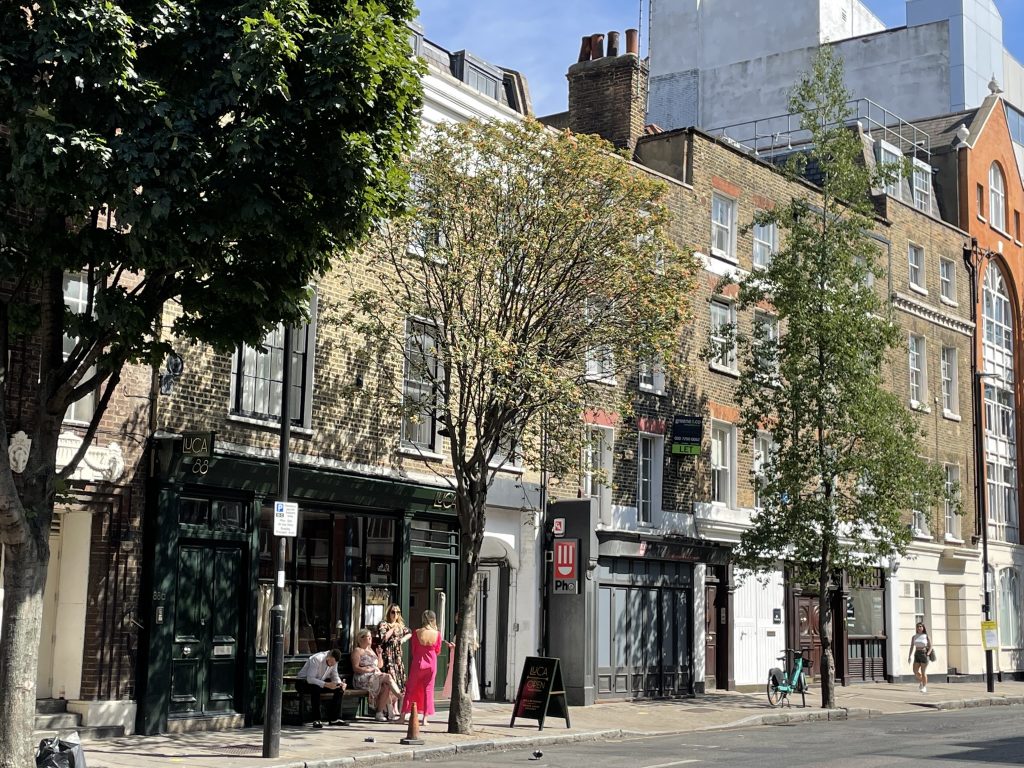St John Street takes its name from the Priory of St John which used to be one of the great Clerkenwell landowners in the Middle Ages. To explain the background a bit, the Order of St John of Jerusalem was a monastic but also a military organisation, and its members were called Knights Hospitallers. They were granted land in Clerkenwell in 1371, and they set up a Priory which owned and controlled all the land between Cowcross Street and Turnmill Street in the south and west, Aylesbury Street in the north, and St John Street in the east.

Not all of the present day St John Street was so called in earlier times. ‘St John Street’ was the name of the lower half of the street roughly from Smithfield to the area of present-day Clerkenwell Road (which didn’t exist until the 19th century). Parts of St John Street to the north were called the Chester Road or Islington Road, and then finally – to make it really complicated – St John Street Road, before the whole lot became merged into a single St John Street in the 20th century.
You can see the basic difference between the two halves even today. The lower part is fundamentally commercial with former warehouses and factories forming most of the buildings on either side, although they are now mainly offices or flats.

By contrast, the upper part of the street was mainly flanked by separate family estates who built terraces of houses, along the lines of the Victorian residential developments in West London. Many of these terraces still exist. Some have been replaced by council estates.
St John Street became one of the major routes, particularly for cattle drovers, driving cattle from the North, through Islington, and down to the Smithfield livestock market, which had existed since the 10th century. There was also a separate cattle market at Cowcross Street and a skin market near Northampton Square.
The movement of all this livestock levied such a toll on the fabric of the road that a royal decree of 1380 allowed the locals to levy a literal toll on the movement of animals and goods between Islington and Smithfield to fund the upkeep of the road.
With so many people travelling up and down the road, inns and taverns began to line the street. Many of them were run by the local religious organisations to make money for themselves and to provide lodgings for their visitors.
After the ‘Dissolution of the Monasteries’ by Henry VIII, the taverns continued in business, but now in private ownership. There were also coffeehouses and eating houses. Hospitality remained one of the main businesses of the area until the 18th century.
The weird situation for many centuries was that, on the one hand St John Street was like the Marylebone High Street of its day, with bars and restaurants, but on the other hand herds of cattle and horses were being constantly driven along it, destined for the Smithfield markets.
The actual livestock market was moved north of King’s Cross in 1855 and that ended the movement of live cattle down St John Street. But the City of London then created the new covered market on the old Smithfield market site, to trade in meat and poultry. This led to a huge influx of businesses involved in the meat processing business, which took up premises at the lower end of St John Street. These included wholesale butchers, sausage and sausage skin makers, tripe dressers and bacon curers.
The sausage business grew so dramatically that one businessman became known in the press as “the Sausage King”. But sausages were outstripped by the popularity of bacon. Bacon smokeries and their kilns proliferated all over the back streets and yards beyond St John Street and Cowcross Street.

In the 20th century, the smokeries is were gradually dismantled and replaced by factories and warehouses, which were themselves finally replaced by offices and apartments, so that the result is the pleasant environment we enjoy today.
Many inns and taverns survived into the 20th century, only to disappear during the redevelopment of the 1980s and later. Many were simply demolished and replaced with entirely new buildings. But some are still visible despite the conversion of their building into offices or restaurants.
